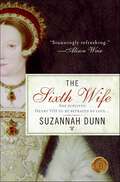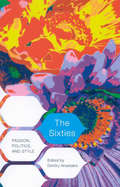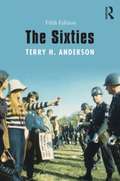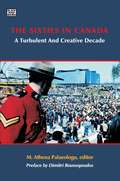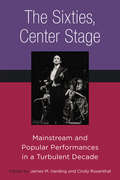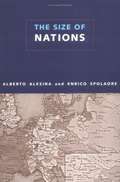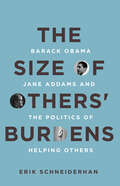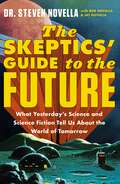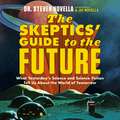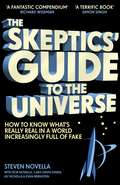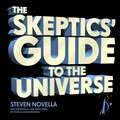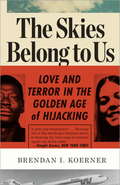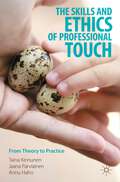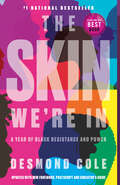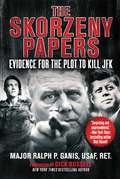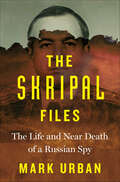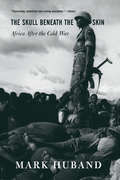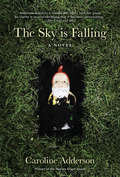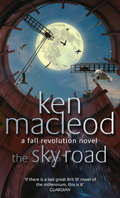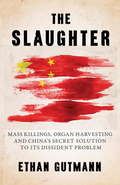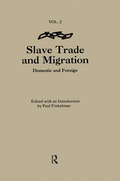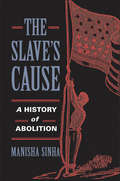- Table View
- List View
The Sixth Wife: A Novel
by Suzannah DunnA gripping novel of love, passion, betrayal, and heartbreak in the unstable Tudor court following the death of King Henry VIIIClever, level-headed Katherine Parr has suffered through four years of marriage to the aging and irascible King Henry VIII—and she has survived, unlike the five wives who came before her. But less than a year after the old king's death, her heart is won by the dashing Thomas Seymour, and their hasty union undoes a lifetime of prudent caution.An unwilling witness to the queen's late-blossoming love, Catherine, Duchess of Suffolk, harbors nagging suspicions of Kate's handsome and ambitious new husband. But as Catherine is drawn deeper into the web of politics ensnaring her oldest friend, it gradually becomes clear that she has her own dark tale to tell. For though Thomas might betray his wife for power, Catherine might betray her for passion, risking everything she has in a world where love is a luxury not even royalty can easily afford.
The Sixties
by Dimitry AnastakisThose who didn't live through the Sixties wonder what the fuss was all about, while many of those who were there have wrestled with how to describe and define the period. While the ultimate meaning of the Sixties remains elusive, there is no doubt that they had an immense effect on Canadians - culturally, politically, and economically. The Sixties takes a multidisciplinary approach that includes history, architecture, art, political science, and journalism. Contributors examine a range of eclectic issues - from the intersection of Joyce Wieland's artwork with Pierre Trudeau's nationalism, to the debate over the changing skylines of Toronto and Montreal, to de Gaulle's famous 1967 "Vive le Québec libre!" speech - to provide a distinctly Canadian perspective on one of the liveliest and most debated periods in modern history. Four decades after Canada's own Expo 67 "summer of love," this timely book conjures up the images, sounds, and tastes of a decade that remains an indelible part of our twenty-first century experience. Contributors include Gretta Chambers (McGill), Christopher Dummitt (Trent), Olivier Courteaux (Ryerson), Frances Early (Mount Saint Vincent), Kristy Holmes (Queen's), Marcel Martel (York), Nicholas Olsberg (Canadian Centre for Architecture), Francine Vanlaethem (UQAM), and Krys Verrall (York)."
The Sixties
by Terry H. AndersonIn "The Sixties," Terry Anderson tackles the question of why American experienced a full decade of tumult and change, whose reverberations and consequences are still being felt in America today. Always appreciated for its brevity, wit and captivating style, "The Sixties" enters its third edition with expanded coverage of the most interesting and important events, people and movements of the Sixties.
The Sixties in Canada
by M. Athena PalaeologuEverywhere the 1960s are being examined and debated. Universities hold international conferences that bring together scholars and activists. Very little has been published about the sixties in Canada, however. This anthology is meant to close that gap. The essays in this volume reflect a minefield of research material that has been brought together from a rich reservoir of sources, heretofore little known.Contributors include Bryan Palmer, Jonathan Thompson, Anne Hoefnagels, Pat Smart, Sean Mills, Gillian Helfield, Myrna Kostash, John Cleveland, Paul Jackson, Carrie Dickenson, Eric Morton, Barbara Goddard, Laurence Davis, Kristin Ireland, Chris Harris, Kevin Brushett, and Dimitrios Roussopoulos.
The Sixties, Center Stage: Mainstream and Popular Performances in a Turbulent Decade
by James M. Harding Cindy RosenthalThe Sixties, Center Stage offers rich insights into the innovative and provocative political underpinnings of mainstream and popular performances in the 1960s. While much critical attention has been focused on experimental and radical theater of the period, the essays confirm that mainstream performances not only merit more scholarly attention than they have received, but through serious examination provide an important key to understanding the 1960s as a period. The introduction provides a broad overview of the social, political, and cultural contexts of artistic practices in mainstream theater from the mid-fifties to mid-seventies. Readers will find detailed examinations of the mainstream’s surprising attention to craft and innovation; to the rich exchange between European and American theatres; to the rise of regional theaters; and finally, to popular cultural performances that pushed the conceptual boundaries of mainstream institutions. The book looks afresh at productions of Hair, Cabaret, Raisin in the Sun, and Fiddler on the Roof, as well as German theater, and performances outside the Democratic National Convention of 1968.
The Sixties: Passion, Politics, and Style
by Dimitry AnastakisThose who didn't live through the Sixties wonder what the fuss was all about, while many of those who were there have wrestled with how to describe and define the period. While the ultimate meaning of the Sixties remains elusive, there is no doubt that they had an immense effect on Canadians - culturally, politically, and economically. The Sixties takes a multidisciplinary approach that includes history, architecture, art, political science, and journalism. Contributors examine a range of eclectic issues - from the intersection of Joyce Wieland's artwork with Pierre Trudeau's nationalism, to the debate over the changing skylines of Toronto and Montreal, to de Gaulle's famous 1967 "Vive le Québec libre!" speech - to provide a distinctly Canadian perspective on one of the liveliest and most debated periods in modern history. Four decades after Canada's own Expo 67 "summer of love," this timely book conjures up the images, sounds, and tastes of a decade that remains an indelible part of our twenty-first century experience. Contributors include Gretta Chambers (McGill), Christopher Dummitt (Trent), Olivier Courteaux (Ryerson), Frances Early (Mount Saint Vincent), Kristy Holmes (Queen's), Marcel Martel (York), Nicholas Olsberg (Canadian Centre for Architecture), Francine Vanlaethem (UQAM), and Krys Verrall (York)."
The Size of Government and U.S.-European Differences in Economic Performance
by Gerwin Bell Norikazu TawaraA report from the International Monetary Fund.
The Size of Nations
by Alberto Alesina Enrico SpolaoreReceived Honorable Mention in the category of Economics in the 2003 Professional/Scholarly Publishing Annual Awards Competition presented by the Association of American Publishers, Inc. The authors of this timely and provocative book use the tools of economic analysis to examine the formation and change of political borders. They argue that while these issues have always been at the core of historical analysis, international economists have tended to regard the size of a country as "exogenous," or no more subject to explanation than the location of a mountain range or the course of a river. Alesina and Spolaore consider a country's borders to be subject to the same analysis as any other man-made institution. In The Size of Nations, they argue that the optimal size of a country is determined by a cost-benefit trade-off between the benefits of size and the costs of heterogeneity. In a large country, per capita costs may be low, but the heterogeneous preferences of a large population make it hard to deliver services and formulate policy. Smaller countries may find it easier to respond to citizen preferences in a democratic way. Alesina and Spolaore substantiate their analysis with simple analytical models that show how the patterns of globalization, international conflict, and democratization of the last two hundred years can explain patterns of state formation. Their aim is not only "normative" but also "positive"--that is, not only to compute the optimal size of a state in theory but also to explain the phenomenon of country size in reality. They argue that the complexity of real world conditions does not preclude a systematic analysis, and that such an analysis, synthesizing economics, political science, and history, can help us understand real world events.
The Size of Others' Burdens: Barack Obama, Jane Addams, and the Politics of Helping Others
by Erik SchneiderhanAmericans have a fierce spirit of individualism. We pride ourselves on self-reliance, on bootstrapping our way to success. Yet, we also believe in helping those in need, and we turn to our neighbors in times of crisis. The tension between these competing values is evident, and how we balance between these competing values holds real consequences for community health and well-being. In his new book, The Size of Others' Burdens, Erik Schneiderhan asks how people can act in the face of competing pressures, and explores the stories of two famous Americans to develop present-day lessons for improving our communities. Although Jane Addams and Barack Obama are separated by roughly one hundred years, the parallels between their lives are remarkable: Chicago activists-turned-politicians, University of Chicago lecturers, gifted orators, crusaders against discrimination, winners of the Nobel Peace Prize. Addams was the founder of Hull-House, the celebrated American "settlement house" that became the foundation of modern social work. Obama's remarkable rise to the presidency is well known. Through the stories of Addams's and Obama's early community work, Erik Schneiderhan challenges readers to think about how many of our own struggles are not simply personal challenges, but also social challenges. How do we help others when so much of our day-to-day life is geared toward looking out for ourselves, whether at work or at home? Not everyone can run for president or win a Nobel Prize, but we can help others without sacrificing their dignity or our principles. Great thinkers of the past and present can give us the motivation; Addams and Obama show us how. Schneiderhan highlights the value of combining today's state resources with the innovation and flexibility of Addams's time to encourage community building. Offering a call to action, this book inspires readers to address their own American dilemma and connect to community, starting within our own neighborhoods.
The Skeptics' Guide to the Future
by Steven NovellaPre-order now: the new book from the bestselling authors and hosts of the wildy popular 'The Skeptics Guide to the Universe'__________Our predictions of the future are a wild fantasy, inextricably linked to our present hopes and fears, biases and ignorance. Whether they be the outlandish leaps predicted in the 1920s, like multi-purpose utility belts with climate control capabilities and planes the size of luxury cruise ships, or the forecasts of the '60s, which didn't anticipate the sexual revolution or women's liberation, the path to the present is littered with failed predictions and incorrect estimations.The best we can do is try to absorb from futurism's checkered past, perhaps learning to do a little better.In The Skeptics' Guide To The Future, Steven Novella and his co-authors build upon the work of futurists of the past by examining what they got right, what they got wrong, and how they came to those conclusions. By exploring the pitfalls of each era, they give their own speculations about the distant future, transformed by unbelievable technology ranging from genetic manipulation to artificial intelligence and quantum computing. Applying their trademark skepticism, they carefully extrapolate upon each scientific development, leaving no stone unturned as they lay out a vision for the future of tomorrow.__________
The Skeptics' Guide to the Future
by Steven NovellaFrom the bestselling authors and hosts of 'The Skeptics' Guide to the Universe' a high-tech roadmap of the future in their beloved voice, cracking open both the follies of futurists past and how technology will profoundly change our world moving forward.__________Our predictions of the future are a wild fantasy, inextricably linked to our present hopes and fears, biases and ignorance. Whether they be the outlandish leaps predicted in the 1920s, like multi-purpose utility belts with climate control capabilities and planes the size of luxury cruise ships, or the forecasts of the '60s, which didn't anticipate the sexual revolution or women's liberation, the path to the present is littered with failed predictions and incorrect estimations.The best we can do is try to absorb from futurism's checkered past, perhaps learning to do a little better.In The Skeptics' Guide To The Future, Steven Novella and his co-authors build upon the work of futurists of the past by examining what they got right, what they got wrong, and how they came to those conclusions. By exploring the pitfalls of each era, they give their own speculations about the distant future, transformed by unbelievable technology ranging from genetic manipulation to artificial intelligence and quantum computing. Applying their trademark skepticism, they carefully extrapolate upon each scientific development, leaving no stone unturned as they lay out a vision for the future of tomorrow.__________(P) 2022 Hachette Audio
The Skeptics' Guide to the Universe: How To Know What's Really Real in a World Increasingly Full of Fake
by Steven Novella'A fantastic compendium of skeptical thinking and the perfect primer for anyone who wants to separate fact from fiction.' Richard Wiseman, author 59 Seconds'Thorough, informative, and enlightening... If this book does not become required reading for us all, we may well see modern civilization unravel before our eyes.' Neil deGrasse Tyson, author of Astrophysics for People in a HurryIn this tie-in to their popular 'The Skeptics Guide to the Universe' podcast, Steven Novella, along with 'Skeptical Rogues' Bob Novella, Cara Santa Maria, Jay Novella and Evan Bernstein explain the tenets of skeptical thinking and debunk some of the biggest scientific myths, fallacies and conspiracy theories (anti-vaccines, homeopathy, UFO sightings, and many more.) They'll help us try to make sense of what seems like an increasingly crazy world using powerful tools like science and philosophy. The Skeptics' Guide to the Universe is your guide through this maze of modern life. It covers essential critical thinking skills, as well as giving insight into how your brain works and how to avoid common pitfalls in thinking. They discuss the difference between science and pseudoscience, how to recognize common science news tropes, how to discuss conspiracy theories with that crazy colleague of yours, and how to apply all of this to everyday life.As fascinating as it is entertaining, this page turner is your essential guide to seeing through the fake news and media manipulation in our increasingly confusing world.
The Skeptics' Guide to the Universe: How To Know What's Really Real in a World Increasingly Full of Fake
by Steven Novella'A fantastic compendium of skeptical thinking and the perfect primer for anyone who wants to separate fact from fiction.' Richard Wiseman, author 59 Seconds'Thorough, informative, and enlightening... If this book does not become required reading for us all, we may well see modern civilization unravel before our eyes.' Neil deGrasse Tyson, author of Astrophysics for People in a HurryAn entertaining and all-encompassing guide to skeptical thinking for the age of misinformation.In this tie-in to their popular 'The Skeptics Guide to the Universe' podcast, Steven Novella, along with 'Skeptical Rogues' Bob Novella, Cara Santa Maria, Jay Novella and Evan Bernstein explain the tenets of skeptical thinking and debunk some of the biggest scientific myths, fallacies and conspiracy theories (anti-vaccines, homeopathy, UFO sightings, and many more.) They'll help us try to make sense of what seems like an increasingly crazy world using powerful tools like science and philosophy. The Skeptics' Guide to the Universe is your guide through this maze of modern life. It covers essential critical thinking skills, as well as giving insight into how your brain works and how to avoid common pitfalls in thinking. They discuss the difference between science and pseudoscience, how to recognize common science news tropes, how to discuss conspiracy theories with that crazy colleague of yours, and how to apply all of this to everyday life.As fascinating as it is entertaining, this page turner is your essential guide to seeing through the fake news and media manipulation in our increasingly confusing world.(P)2018 Hachette Audio
The Skies Belong to Us: Love and Terror in the Golden Age of Hijacking
by Brendan I. KoernerIn an America torn apart by the Vietnam War and the demise of '60s idealism, airplane hijackings were astonishingly routine. Over a five-year period starting in 1968, the desperate and disillusioned seized commercial jets nearly once a week, using guns, bombs, and jars of acid. Some hijackers wished to escape to foreign lands; others aimed to swap hostages for sacks of cash. Their criminal exploits mesmerized the country, never more so than when shattered Army veteran Roger Holder and mischievous party girl Cathy Kerkow managred to comandeer Western Airlines Flight 701 and flee across an ocean with a half-million dollars in ransom--a heist that remains the longest-distance hijacking in American history.More than just an enthralling story about a spectacular crime and its bittersweet, decades-long aftermath, The Skies Belong to Us is also a psychological portrait of America at its most turbulent and a testament to the madness that can grip a nation when politics fail. tale, which involves a cast of characters ranging from exiled Black Panthers to African despots to French movie stars. He combed through over 4,000 declassified documents and interviewed scores of key figures in the drama--including one of the hijackers, whom Koerner discovered living in total obscurity. Yet The Skies Belong to Us is more than just an enthralling yarn about a spectacular heist and its bittersweet, decades-long aftermath. It is also a psychological portrait of America at its most turbulent, and a testament to the madness that can grip a nation when politics fail.
The Skills and Ethics of Professional Touch: From Theory to Practice
by Taina Kinnunen Jaana Parviainen Annu HahoThis book introduces readers to the ethical and goal-oriented functions of touch in professional practice. Touch is both an increasingly visible topic today and a core skill in many professions, especially in health, education and social work. This book combines helpful theoretical discussions and practical information, offering a balanced and culturally-informed introduction to an issue that both students and professionals often find difficult to navigate. Chapters discuss the various functions of touch and its uses, giving readers a deeper understanding of the potential of tactile work practices. The authors offer clear legal and ethical guidance to empower learners. They discuss key issues such as harmful touch and the increasing digitisation of patient work. Activities, case studies and further readings promote learning and help readers reflect on their own relationship to touch. This book will be an invaluable resource for students in undergraduate and graduate courses in healthcare, nursing, education and social work, and to practitioners looking for guidance on this topic.
The Skin We're In: A Year of Black Resistance and Power
by Desmond ColeA bracing, provocative, and perspective-shifting book from one of Canada's most celebrated and uncompromising writers, Desmond Cole. The Skin We're In will spark a national conversation, influence policy, and inspire activists. <P><P>In his 2015 cover story for Toronto Life magazine, Desmond Cole exposed the racist actions of the Toronto police force, detailing the dozens of times he had been stopped and interrogated under the controversial practice of carding. The story quickly came to national prominence, shaking the country to its core and catapulting its author into the public sphere. Cole used his newfound profile to draw insistent, unyielding attention to the injustices faced by Black Canadians on a daily basis. <P><P>Both Cole’s activism and journalism find vibrant expression in his first book, The Skin We’re In. Puncturing the bubble of Canadian smugness and naive assumptions of a post-racial nation, Cole chronicles just one year—2017—in the struggle against racism in this country. It was a year that saw calls for tighter borders when Black refugees braved frigid temperatures to cross into Manitoba from the States, Indigenous land and water protectors resisting the celebration of Canada’s 150th birthday, police across the country rallying around an officer accused of murder, and more. <P><P>The year also witnessed the profound personal and professional ramifications of Desmond Cole’s unwavering determination to combat injustice. In April, Cole disrupted a Toronto police board meeting by calling for the destruction of all data collected through carding. Following the protest, Cole, a columnist with the Toronto Star, was summoned to a meeting with the paper’s opinions editor and informed that his activism violated company policy. Rather than limit his efforts defending Black lives, Cole chose to sever his relationship with the publication. Then in July, at another police board meeting, Cole challenged the board to respond to accusations of a police cover-up in the brutal beating of Dafonte Miller by an off-duty police officer and his brother. When Cole refused to leave the meeting until the question was publicly addressed, he was arrested. The image of Cole walking out of the meeting, handcuffed and flanked by officers, fortified the distrust between the city’s Black community and its police force. <P><P>Month-by-month, Cole creates a comprehensive picture of entrenched, systemic inequality. Urgent, controversial, and unsparingly honest, The Skin We’re In is destined to become a vital text for anti-racist and social justice movements in Canada, as well as a potent antidote to the all-too-present complacency of many white Canadians.
The Skorzeny Papers: Evidence for the Plot to Kill JFK
by Dick Russell Ret. Major Ralph P. Ganis UsafIn The Skorzeny Papers, the author reveals the details of the post-World War II activities of former SS Commando Otto Skorzeny. Considered by British and American Allied forces as “the most dangerous man in Europe,” Skorzeny planned and led numerous daring missions throughout the war. The story in this book was extracted by Major Ganis from Skorzeny’s personal papers. The evidence reveals that Skorzeny gradually and methodically became involved in US intelligence and covert operations during the Cold War. But Skorzeny’s network had a greater point of destiny in November 1963, when it was utilized to carry out the most tragic mission in history. This story would have been lost had Skorzeny not kept meticulous records of his businesses and contacts, which were fronts for US covert activity. In the end, The Skorzeny Papers reveal the intriguing web of secret organizations and people linked to the events culminating in the assassination of President John F. Kennedy.
The Skripal Files: The Life and Near Death of a Russian Spy
by Mark UrbanThe explosive story of the poisoning of the former Russian spy Sergei Skripal and what it reveals about the growing clandestine conflict between the West and RussiaSalisbury, England: March 4, 2018.Slumped on a bench, paralyzed and barely able to breathe, were a former Russian intelligence officer named Sergei Skripal and his daughter, Yulia. Sergei had been living a quiet life in England since 2010, when he was expelled from Russia as part of a spy swap; he had been serving a lengthy prison sentence for working secretly for the British intelligence agency MI6. On this Sunday afternoon, he and his daughter had just finished lunch at a local restaurant when they started to feel faint. Within minutes they were close to death.The Skripals had been poisoned, not with a familiar toxin but with Novichok, a deadly nerve agent developed in southern Russia. Was this a message from the Kremlin that traitors would not escape violent death, even on British soil? As Sergei and Yulia fought for their lives, and the British government and their allies sought answers, relations between the West and Russia descended to a new low.The Skripal Files is a remarkable and definitive account of Sergei Skripal’s story, which lays bare the new spy war between Russia and the West. Mark Urban, the diplomatic and defense editor for the BBC, met with Skripal in the months before his poisoning, learning about his career in Russian military intelligence, how he became a British agent, his imprisonment in Russia, and the events that led to his release. Skripal’s first-hand accounts and experiences reveal the high stakes of a new spy game that harks back to the chilliest days of the Cold War.
The Skull Beneath The Skin: Africa After The Cold War
by Mark HubandIn The Skull Beneath the Skin: Africa After the Cold War award-winning journalist Mark Huband argues that foreign involvement in Africa has been the single most destructive element in the continent's history. He argues that the catastrophes that have erupted since the end of the Cold War are a legacy of that long foreign involvement, and that stab
The Sky Is Falling: A Novel
by Caroline AddersonFrom the winner of the 2006 Marian Engel Award comes a funny, absorbing and timely novel about fear in our time. On a spring day in 2004, Jane Z. a physician’s wife and mother of a teenage son, opens her morning newspaper and is shocked to see a familiar face on the front page. Sonia, a lost friend accused of terrorism, has just been released after twenty years in prison. It all comes flooding back to Jane, how twenty years before her life took a very different course. At nineteen, Jane rents a room in a shared student house with a mismatched trio of idealists: Sonia, who yearns to save the world’s children from nuclear war; the Marxist-leaning Dieter; and the anarcho-feminist-pacifist Pete. A bookish misfit, her radical housemates quickly draw Jane into NAG!, a non-violent, anti-nuclear direct action group. To Jane, who is studying Russian and Russian literature, her compatriots, with their utopian dreams and youthful pathos, soon seem Chekhovian to her. Meanwhile, NAG! plans its most ambitious action, crossing the border into the United States to chain themselves to the Boeing factory fence. Tension increases as the group mounts each successive protest, until a bomb explodes and changes everything. The Sky Is Falling deftly intertwines themes of first love, sexual confusion, and the dread of nuclear disaster with the comical infighting of a cast of well-meaning political activists, and the timelessness of the great Russian classics. A story for our own age of paranoia and terror, Caroline Adderson’s witty, accomplished novel returns the reader to another fearful era, when the world teetered on the brink of nuclear annihilation and the end of world seemed inevitable.
The Sky Road: Book Four: The Fall Revolution Series (Fall Revolution Ser. #4)
by Ken MacLeod'Exciting...Accessible to the average reader as well as the hardcore SF fan. This is a work sure to keep the reader on the edge of her seat.' - Romantic Times Bookclub'For my money, Ken MacLeod is the current champion of the very smartest kind of New Space Opera... every variation on his themes produces something worth re-reading.' - LocusCenturies after its catastrophic Deliverance, humanity is again reaching into space. And one young scholar working in the space ship yard, Clovis colha Gree, could make the difference between success and failure. For his mysterious lover, Merrial, has seduced him into the idea of extrapolating the ship's future from the dark archives of the past.A past in which, centuries before, Myra Godwin faced the end of a different space age - her rockets redundant, her people rebellious, and her borders defenceless against the Sino-Soviet Union. As Myra appealed to the falling empires of the West for help, she found history turning on her own dubious past - and on her present decisions. Decisions which, centuries later, will determine the future of the new space age. Merrial's people, the itinerant computer engineers, know this. And they know that the truth they seek lies within the secret files left by Myra Godwin.Set hundreds of years in the future, THE SKY ROAD is the astonishing story of the dawn of a new space age, from the most exciting British SF author to have emerged in recent years.Books by Ken MacLeod:Fall RevolutionThe Star FractionThe Stone CanalThe Cassini DivisionThe Sky RoadEngines of LightCosmonaut KeepDark LightEngine CityCorporation Wars TrilogyDissidenceInsurgenceEmergenceNovelsThe Human FrontNewton's WakeLearning the WorldThe Execution ChannelThe Restoration GameIntrusionDescent
The Sky Road: Book Four: The Fall Revolution Series (Fall Revolutions #4)
by Ken MacLeod'Exciting...Accessible to the average reader as well as the hardcore SF fan. This is a work sure to keep the reader on the edge of her seat.' - Romantic Times Bookclub'For my money, Ken MacLeod is the current champion of the very smartest kind of New Space Opera... every variation on his themes produces something worth re-reading.' - LocusCenturies after its catastrophic Deliverance, humanity is again reaching into space. And one young scholar working in the space ship yard, Clovis colha Gree, could make the difference between success and failure. For his mysterious lover, Merrial, has seduced him into the idea of extrapolating the ship's future from the dark archives of the past.A past in which, centuries before, Myra Godwin faced the end of a different space age - her rockets redundant, her people rebellious, and her borders defenceless against the Sino-Soviet Union. As Myra appealed to the falling empires of the West for help, she found history turning on her own dubious past - and on her present decisions. Decisions which, centuries later, will determine the future of the new space age. Merrial's people, the itinerant computer engineers, know this. And they know that the truth they seek lies within the secret files left by Myra Godwin.Set hundreds of years in the future, THE SKY ROAD is the astonishing story of the dawn of a new space age, from the most exciting British SF author to have emerged in recent years.Books by Ken MacLeod:Fall RevolutionThe Star FractionThe Stone CanalThe Cassini DivisionThe Sky RoadEngines of LightCosmonaut KeepDark LightEngine CityCorporation Wars TrilogyDissidenceInsurgenceEmergenceNovelsThe Human FrontNewton's WakeLearning the WorldThe Execution ChannelThe Restoration GameIntrusionDescent
The Slaughter
by Ethan GutmannThe inside story of China's organ transplant business and its macabre connection with internment camps and killing fields for arrested dissidents, especially the adherents of Falun Gong.Mass murder is alive and well. That is the stark conclusion of this comprehensive investigation into the Chinese state's secret program to get rid of political dissidents while profiting from the sale of their organs--in many cases to Western recipients. Based on interviews with top-ranking police officials and Chinese doctors who have killed prisoners on the operating table, veteran China analyst Ethan Gutmann has produced a riveting insider's account--culminating in a death toll that will shock the world. Why would the Chinese leadership encourage such a dangerous perversion of their medical system? To solve the puzzle, Gutmann journeyed deep into the dissident archipelago of Falun Gong, Tibetans, Uighurs and House Christians, uncovering an ageless drama of resistance, eliciting confessions of deep betrayal and moments of ecstatic redemption. In an age of compassion fatigue, Gutmann relies on one simple truth: those who have made it back from the gates of hell have stories to tell. And no matter what baggage the reader may bring along, their preconceptions of China will not survive the trip.From the Hardcover edition.
The Slave Trade & Migration (Articles on American Slavery)
by Paul FinkelmanFirst Published in 1990. Routledge is an imprint of Taylor & Francis, an informa company.
The Slave's Cause: A History of Abolition
by Manisha Sinha&“Traces the history of abolition from the 1600s to the 1860s . . . a valuable addition to our understanding of the role of race and racism in America.&”—Florida Courier Received historical wisdom casts abolitionists as bourgeois, mostly white reformers burdened by racial paternalism and economic conservatism. Manisha Sinha overturns this image, broadening her scope beyond the antebellum period usually associated with abolitionism and recasting it as a radical social movement in which men and women, black and white, free and enslaved found common ground in causes ranging from feminism and utopian socialism to anti-imperialism and efforts to defend the rights of labor. Drawing on extensive archival research, including newly discovered letters and pamphlets, Sinha documents the influence of the Haitian Revolution and the centrality of slave resistance in shaping the ideology and tactics of abolition. This book is a comprehensive history of the abolition movement in a transnational context. It illustrates how the abolitionist vision ultimately linked the slave&’s cause to the struggle to redefine American democracy and human rights across the globe. &“A full history of the men and women who truly made us free.&”—Ira Berlin, The New York Times Book Review &“A stunning new history of abolitionism . . . [Sinha] plugs abolitionism back into the history of anticapitalist protest.&”—The Atlantic &“Will deservedly take its place alongside the equally magisterial works of Ira Berlin on slavery and Eric Foner on the Reconstruction Era.&”—The Wall Street Journal &“A powerfully unfamiliar look at the struggle to end slavery in the United States . . . as multifaceted as the movement it chronicles.&”—The Boston Globe
